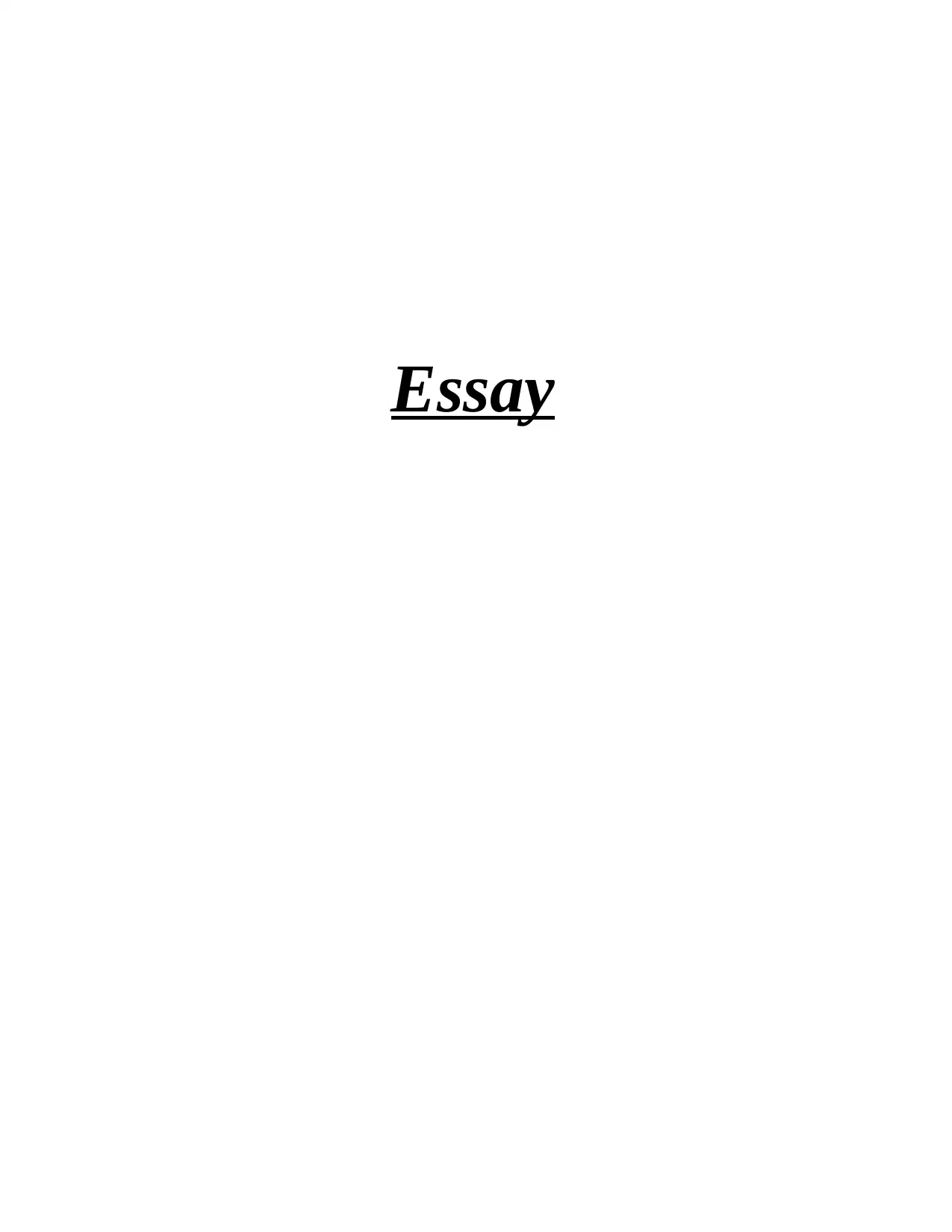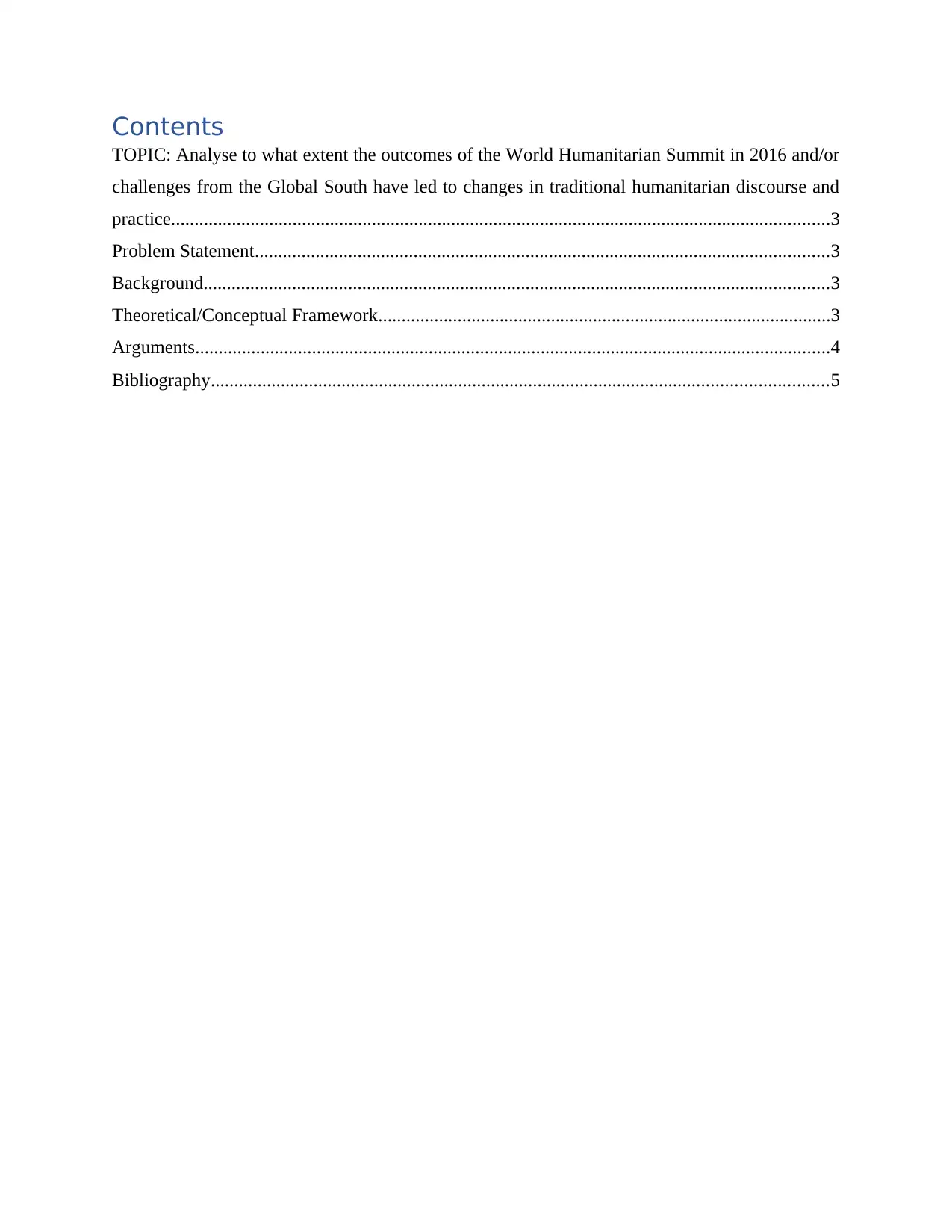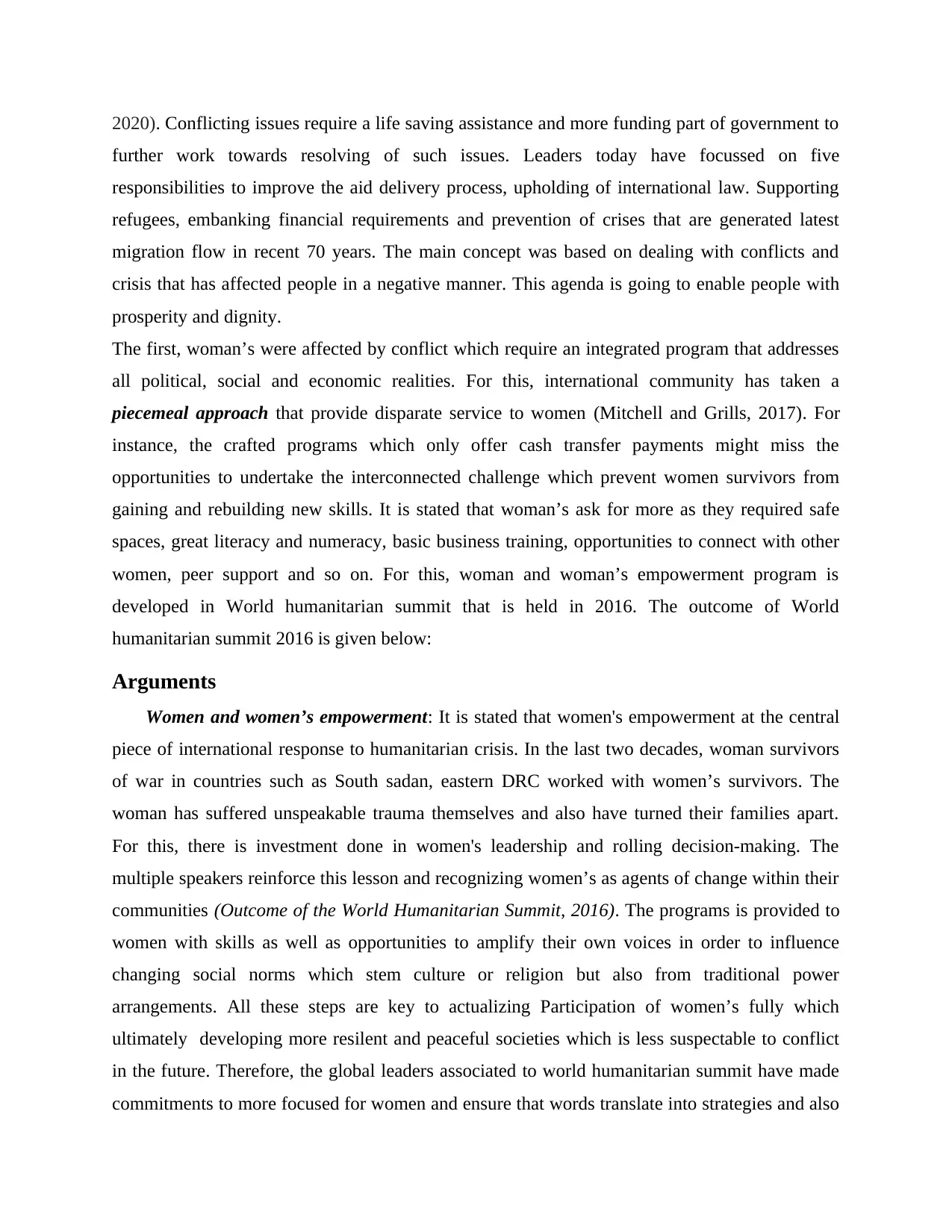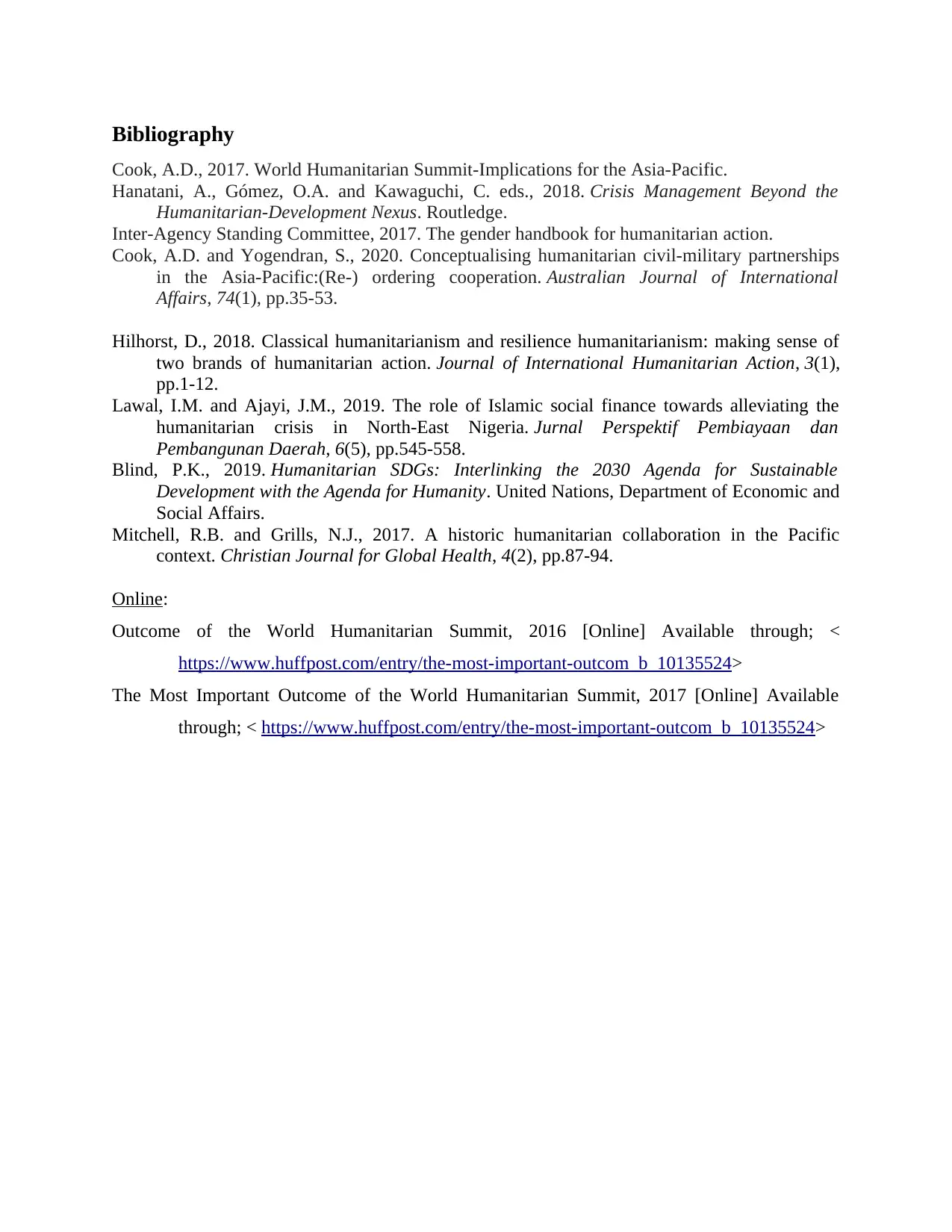Changes in Humanitarian Discourse: World Humanitarian Summit 2016
VerifiedAdded on 2022/11/28
|6
|1480
|359
Essay
AI Summary
This essay delves into the outcomes of the World Humanitarian Summit (WHS) held in 2016, examining its influence on traditional humanitarian discourse and practices, with a particular focus on challenges originating from the Global South. The essay begins by outlining the summit's objective to reform the humanitarian aid industry and its key commitments. It then explores the shift in actors involved, including the increased role of middle-income countries and the growth of NGOs in the Global South. The conceptual framework centers on conflict resolution, women's empowerment, and addressing the needs of people in conflict zones. The essay analyzes arguments related to women's empowerment, the needs of people in conflict, and the formation of partnerships for effective humanitarian action. It highlights the importance of women's leadership, equitable assistance, and coordination among various actors. Finally, the essay references key literature related to the summit and its impact on humanitarian aid.

Essay
Paraphrase This Document
Need a fresh take? Get an instant paraphrase of this document with our AI Paraphraser

Contents
TOPIC: Analyse to what extent the outcomes of the World Humanitarian Summit in 2016 and/or
challenges from the Global South have led to changes in traditional humanitarian discourse and
practice.............................................................................................................................................3
Problem Statement...........................................................................................................................3
Background......................................................................................................................................3
Theoretical/Conceptual Framework.................................................................................................3
Arguments........................................................................................................................................4
Bibliography....................................................................................................................................5
TOPIC: Analyse to what extent the outcomes of the World Humanitarian Summit in 2016 and/or
challenges from the Global South have led to changes in traditional humanitarian discourse and
practice.............................................................................................................................................3
Problem Statement...........................................................................................................................3
Background......................................................................................................................................3
Theoretical/Conceptual Framework.................................................................................................3
Arguments........................................................................................................................................4
Bibliography....................................................................................................................................5

TOPIC: Analyse to what extent the outcomes of the World Humanitarian
Summit in 2016 from the Global South have led to changes in traditional
humanitarian discourse and practice.
Problem Statement
The World humanitarian summit 2016 objective was to fundamentally reform the
humanitarian aid industry to react more efficiently to today’s crises. In addition to this, the
summit generated over 2500 alignments and 3000 commitments to action with core
commitments to deliver the agenda for humanity (Blind, 2019). The report will cover the
outcome of world humanitarian summit 2016 that leads to change in traditional humanitarian
disclosure as well as practices. It is stated that this summit has important shift in the nature and
number of actors involved within humanitarian actions. As more countries reach middle income
statement, involving through increased out South cooperation, government become providers and
owners of kind assistance, the number of NGOS is grown with the major increase in global
South. In context to challenges, humanitarian actors have sought to enhance their services and
optimally influence on people in need.
Background
The summit was held that basically targeted four humanitarian constituencies that included
member’s states, global network of humanitarian organisations, affected people and other
associated partners. World humanitarian summit was held in Istanbul Turkey in May 24 and 23
in year 2016. It was a basic iniative of secretary general of United Nations Ban ki moon and was
further organised by United Nations office for coordination of humanitarian affairs (UN OCHA).
His main aim was to fundamentally reform the humanitarian aid industry to react effectively in
the present crises (Inter-Agency Standing Committee, 2017). World leaders are also expected to
participate in the summit and actions that have to be taken to end the suffering of millions of
children, men and women that are affected by disasters and armed conflicts.
Theoretical/Conceptual Framework
The main conceptual framework associated with various measures includes the issue of
conflict that is arsing in organisations. Dealing with the conflicts taking place between people is
one of the major issues and is a conceptual problem faced by people (Cook and Yogendran,
Summit in 2016 from the Global South have led to changes in traditional
humanitarian discourse and practice.
Problem Statement
The World humanitarian summit 2016 objective was to fundamentally reform the
humanitarian aid industry to react more efficiently to today’s crises. In addition to this, the
summit generated over 2500 alignments and 3000 commitments to action with core
commitments to deliver the agenda for humanity (Blind, 2019). The report will cover the
outcome of world humanitarian summit 2016 that leads to change in traditional humanitarian
disclosure as well as practices. It is stated that this summit has important shift in the nature and
number of actors involved within humanitarian actions. As more countries reach middle income
statement, involving through increased out South cooperation, government become providers and
owners of kind assistance, the number of NGOS is grown with the major increase in global
South. In context to challenges, humanitarian actors have sought to enhance their services and
optimally influence on people in need.
Background
The summit was held that basically targeted four humanitarian constituencies that included
member’s states, global network of humanitarian organisations, affected people and other
associated partners. World humanitarian summit was held in Istanbul Turkey in May 24 and 23
in year 2016. It was a basic iniative of secretary general of United Nations Ban ki moon and was
further organised by United Nations office for coordination of humanitarian affairs (UN OCHA).
His main aim was to fundamentally reform the humanitarian aid industry to react effectively in
the present crises (Inter-Agency Standing Committee, 2017). World leaders are also expected to
participate in the summit and actions that have to be taken to end the suffering of millions of
children, men and women that are affected by disasters and armed conflicts.
Theoretical/Conceptual Framework
The main conceptual framework associated with various measures includes the issue of
conflict that is arsing in organisations. Dealing with the conflicts taking place between people is
one of the major issues and is a conceptual problem faced by people (Cook and Yogendran,
⊘ This is a preview!⊘
Do you want full access?
Subscribe today to unlock all pages.

Trusted by 1+ million students worldwide

2020). Conflicting issues require a life saving assistance and more funding part of government to
further work towards resolving of such issues. Leaders today have focussed on five
responsibilities to improve the aid delivery process, upholding of international law. Supporting
refugees, embanking financial requirements and prevention of crises that are generated latest
migration flow in recent 70 years. The main concept was based on dealing with conflicts and
crisis that has affected people in a negative manner. This agenda is going to enable people with
prosperity and dignity.
The first, woman’s were affected by conflict which require an integrated program that addresses
all political, social and economic realities. For this, international community has taken a
piecemeal approach that provide disparate service to women (Mitchell and Grills, 2017). For
instance, the crafted programs which only offer cash transfer payments might miss the
opportunities to undertake the interconnected challenge which prevent women survivors from
gaining and rebuilding new skills. It is stated that woman’s ask for more as they required safe
spaces, great literacy and numeracy, basic business training, opportunities to connect with other
women, peer support and so on. For this, woman and woman’s empowerment program is
developed in World humanitarian summit that is held in 2016. The outcome of World
humanitarian summit 2016 is given below:
Arguments
Women and women’s empowerment: It is stated that women's empowerment at the central
piece of international response to humanitarian crisis. In the last two decades, woman survivors
of war in countries such as South sadan, eastern DRC worked with women’s survivors. The
woman has suffered unspeakable trauma themselves and also have turned their families apart.
For this, there is investment done in women's leadership and rolling decision-making. The
multiple speakers reinforce this lesson and recognizing women’s as agents of change within their
communities (Outcome of the World Humanitarian Summit, 2016). The programs is provided to
women with skills as well as opportunities to amplify their own voices in order to influence
changing social norms which stem culture or religion but also from traditional power
arrangements. All these steps are key to actualizing Participation of women’s fully which
ultimately developing more resilent and peaceful societies which is less suspectable to conflict
in the future. Therefore, the global leaders associated to world humanitarian summit have made
commitments to more focused for women and ensure that words translate into strategies and also
further work towards resolving of such issues. Leaders today have focussed on five
responsibilities to improve the aid delivery process, upholding of international law. Supporting
refugees, embanking financial requirements and prevention of crises that are generated latest
migration flow in recent 70 years. The main concept was based on dealing with conflicts and
crisis that has affected people in a negative manner. This agenda is going to enable people with
prosperity and dignity.
The first, woman’s were affected by conflict which require an integrated program that addresses
all political, social and economic realities. For this, international community has taken a
piecemeal approach that provide disparate service to women (Mitchell and Grills, 2017). For
instance, the crafted programs which only offer cash transfer payments might miss the
opportunities to undertake the interconnected challenge which prevent women survivors from
gaining and rebuilding new skills. It is stated that woman’s ask for more as they required safe
spaces, great literacy and numeracy, basic business training, opportunities to connect with other
women, peer support and so on. For this, woman and woman’s empowerment program is
developed in World humanitarian summit that is held in 2016. The outcome of World
humanitarian summit 2016 is given below:
Arguments
Women and women’s empowerment: It is stated that women's empowerment at the central
piece of international response to humanitarian crisis. In the last two decades, woman survivors
of war in countries such as South sadan, eastern DRC worked with women’s survivors. The
woman has suffered unspeakable trauma themselves and also have turned their families apart.
For this, there is investment done in women's leadership and rolling decision-making. The
multiple speakers reinforce this lesson and recognizing women’s as agents of change within their
communities (Outcome of the World Humanitarian Summit, 2016). The programs is provided to
women with skills as well as opportunities to amplify their own voices in order to influence
changing social norms which stem culture or religion but also from traditional power
arrangements. All these steps are key to actualizing Participation of women’s fully which
ultimately developing more resilent and peaceful societies which is less suspectable to conflict
in the future. Therefore, the global leaders associated to world humanitarian summit have made
commitments to more focused for women and ensure that words translate into strategies and also
Paraphrase This Document
Need a fresh take? Get an instant paraphrase of this document with our AI Paraphraser

actions that involved components to develop their families, lives and communities is to be
fulfilled.
Serving the needs of people in conflict: The intensity, social and duration of armed conflicts has
caused massive displacement of people it has lead to creation of humanitarian need. There is
requirement of equitable assistance and protection of people who are affected by conflict in
particular zones to active combat that is a critical challenge (Hanatani, Gómez, Oand Kawaguchi,
2018). It is focussed on finding more durable solutions towards displacement and in the urban
areas. There is need for exploring strategies & mechanism so that there can be coordination of
work across the system on such issues. The major outcome of this summit is to create
partnerships for effective humanitarian actions; there is requirement of a forward looking agenda
that has to be incorporated with experiences and interest in a broader range of actors that have
participated in this discussion type. It is associated with active contributors and long standing to
humanitarian response efforts that have to be recognised as part of formal humanitarian system.
The conflict is a major issue that was delay in this summit so that there can be formation of some
measures to explore mechanism and strategies to coordinate work across the system on thee
issues after year 2016 (Cook, 2017). Partnerships for effective humanitarian action: the
suggested measure was to form broadening partnerships for the purpose of proliferation into
operational actors & various aid providers. There was need to develop a forward looking
humanitarian agenda that has to be incorporated. The preparatory process in the summit has to
identify the new forums for coordinating and collaborating the responses and policies with other
partners that includes agencies, governments, private sector, NGO and foundations.
fulfilled.
Serving the needs of people in conflict: The intensity, social and duration of armed conflicts has
caused massive displacement of people it has lead to creation of humanitarian need. There is
requirement of equitable assistance and protection of people who are affected by conflict in
particular zones to active combat that is a critical challenge (Hanatani, Gómez, Oand Kawaguchi,
2018). It is focussed on finding more durable solutions towards displacement and in the urban
areas. There is need for exploring strategies & mechanism so that there can be coordination of
work across the system on such issues. The major outcome of this summit is to create
partnerships for effective humanitarian actions; there is requirement of a forward looking agenda
that has to be incorporated with experiences and interest in a broader range of actors that have
participated in this discussion type. It is associated with active contributors and long standing to
humanitarian response efforts that have to be recognised as part of formal humanitarian system.
The conflict is a major issue that was delay in this summit so that there can be formation of some
measures to explore mechanism and strategies to coordinate work across the system on thee
issues after year 2016 (Cook, 2017). Partnerships for effective humanitarian action: the
suggested measure was to form broadening partnerships for the purpose of proliferation into
operational actors & various aid providers. There was need to develop a forward looking
humanitarian agenda that has to be incorporated. The preparatory process in the summit has to
identify the new forums for coordinating and collaborating the responses and policies with other
partners that includes agencies, governments, private sector, NGO and foundations.

Bibliography
Cook, A.D., 2017. World Humanitarian Summit-Implications for the Asia-Pacific.
Hanatani, A., Gómez, O.A. and Kawaguchi, C. eds., 2018. Crisis Management Beyond the
Humanitarian-Development Nexus. Routledge.
Inter-Agency Standing Committee, 2017. The gender handbook for humanitarian action.
Cook, A.D. and Yogendran, S., 2020. Conceptualising humanitarian civil-military partnerships
in the Asia-Pacific:(Re-) ordering cooperation. Australian Journal of International
Affairs, 74(1), pp.35-53.
Hilhorst, D., 2018. Classical humanitarianism and resilience humanitarianism: making sense of
two brands of humanitarian action. Journal of International Humanitarian Action, 3(1),
pp.1-12.
Lawal, I.M. and Ajayi, J.M., 2019. The role of Islamic social finance towards alleviating the
humanitarian crisis in North-East Nigeria. Jurnal Perspektif Pembiayaan dan
Pembangunan Daerah, 6(5), pp.545-558.
Blind, P.K., 2019. Humanitarian SDGs: Interlinking the 2030 Agenda for Sustainable
Development with the Agenda for Humanity. United Nations, Department of Economic and
Social Affairs.
Mitchell, R.B. and Grills, N.J., 2017. A historic humanitarian collaboration in the Pacific
context. Christian Journal for Global Health, 4(2), pp.87-94.
Online:
Outcome of the World Humanitarian Summit, 2016 [Online] Available through; <
https://www.huffpost.com/entry/the-most-important-outcom_b_10135524>
The Most Important Outcome of the World Humanitarian Summit, 2017 [Online] Available
through; < https://www.huffpost.com/entry/the-most-important-outcom_b_10135524>
Cook, A.D., 2017. World Humanitarian Summit-Implications for the Asia-Pacific.
Hanatani, A., Gómez, O.A. and Kawaguchi, C. eds., 2018. Crisis Management Beyond the
Humanitarian-Development Nexus. Routledge.
Inter-Agency Standing Committee, 2017. The gender handbook for humanitarian action.
Cook, A.D. and Yogendran, S., 2020. Conceptualising humanitarian civil-military partnerships
in the Asia-Pacific:(Re-) ordering cooperation. Australian Journal of International
Affairs, 74(1), pp.35-53.
Hilhorst, D., 2018. Classical humanitarianism and resilience humanitarianism: making sense of
two brands of humanitarian action. Journal of International Humanitarian Action, 3(1),
pp.1-12.
Lawal, I.M. and Ajayi, J.M., 2019. The role of Islamic social finance towards alleviating the
humanitarian crisis in North-East Nigeria. Jurnal Perspektif Pembiayaan dan
Pembangunan Daerah, 6(5), pp.545-558.
Blind, P.K., 2019. Humanitarian SDGs: Interlinking the 2030 Agenda for Sustainable
Development with the Agenda for Humanity. United Nations, Department of Economic and
Social Affairs.
Mitchell, R.B. and Grills, N.J., 2017. A historic humanitarian collaboration in the Pacific
context. Christian Journal for Global Health, 4(2), pp.87-94.
Online:
Outcome of the World Humanitarian Summit, 2016 [Online] Available through; <
https://www.huffpost.com/entry/the-most-important-outcom_b_10135524>
The Most Important Outcome of the World Humanitarian Summit, 2017 [Online] Available
through; < https://www.huffpost.com/entry/the-most-important-outcom_b_10135524>
⊘ This is a preview!⊘
Do you want full access?
Subscribe today to unlock all pages.

Trusted by 1+ million students worldwide
1 out of 6
Your All-in-One AI-Powered Toolkit for Academic Success.
+13062052269
info@desklib.com
Available 24*7 on WhatsApp / Email
![[object Object]](/_next/static/media/star-bottom.7253800d.svg)
Unlock your academic potential
Copyright © 2020–2025 A2Z Services. All Rights Reserved. Developed and managed by ZUCOL.